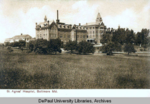Loudon Park Cemetery
1853 establishments in MarylandBurial sites of the House of BonaparteCemeteries established in the 1850sCemeteries in BaltimoreConfederate States of America cemeteries ... and 2 more
Irvington, BaltimoreMaryland in the American Civil War

Loudon Park Cemetery is a historic cemetery in Baltimore, Maryland. It was incorporated on January 27, 1853, on 100 acres (40 ha) of the site of the "Loudon" estate, previously owned by James Carey, a local merchant and politician. The entrance to the cemetery is located at 3620 Wilkens Avenue. The cemetery and Loudon Park Funeral Home, Inc. are locally owned and operated. Both the cemetery and the funeral home became privately owned in 2014 when they were acquired from Service Corporation International (SCI). Loudon Park Funeral Home was built on the grounds of the historic cemetery by Stewart Enterprises in 1995. SCI acquired Stewart Enterprises in 2013.
Excerpt from the Wikipedia article Loudon Park Cemetery (License: CC BY-SA 3.0, Authors, Images).Loudon Park Cemetery
Frederick Avenue, Baltimore
Geographical coordinates (GPS) Address Nearby Places Show on map
Geographical coordinates (GPS)
| Latitude | Longitude |
|---|---|
| N 39.281666666667 ° | E -76.679722222222 ° |
Address
Frederick Avenue 3445
21229 Baltimore
Maryland, United States
Open on Google Maps








